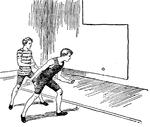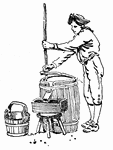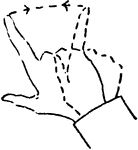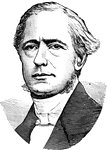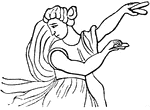
Crotalum
"A kind of cymbal. It appears to have been a split reed or cane, which clattered when shaken with the…
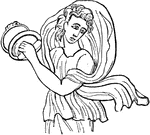
Cymbalum
"A musical instrument, in the shape of two half globes, which were held one in each hand of the performer,…
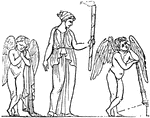
Fax
"A torch. In the annexed woodcut, the female figure is copied from a fictile vase. The winged figure…
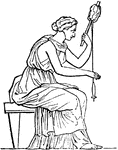
Fusus
"The spindle, was always, when in use, accompanied by the distaff, as an indispensable part of the same…

Ring the Bull
"This amusing game requires more care and delicacy of touch than at first seems to be the case. The…
Whizzer
"Get a circular piece of tin, three inches or more in diameter, and cut it round the edges in the form…

Cudgel Game
"Here is a new game, which is causing a great deal of amusement at social gatherings in Europe. Two…
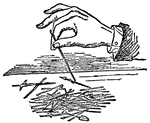
Jackstraws
"This is a game of pure manual dexterity, and is rare practice for cultivating steadiness of hand and…
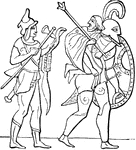
Aeneas and Ascanius
"The following cut, taken from one of Sir W. Hamilton's fictile vases, and representing Aeneas followed…
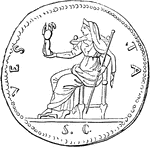
Coin of Vesta
"Represents Vesta seated on a throne, with the Palladium of Rome in her hand." — Anthon, 1891
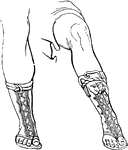
Cothurnus
"The cothurnus or buskin, rose above the midddle of the leg so as to surround the calf (sura),…
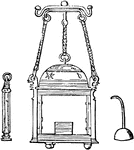
Laterna
"In later Greek, a lantern. Two bronze lanterns, constructed with nicety and skill, have been found…

Banqueting room
"The Roman people reclined at their meals. On each couch there were commonly three persons. They lay…
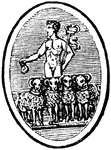
Marsupium
"Marsupium, a purse. The purse used by the ancients was commonly a small leathern bag, and was often…
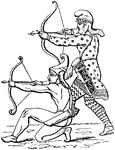
Phaetra
"A quiver, was principally made of hide or leather, and was adorned with gold, painting, and braiding.…
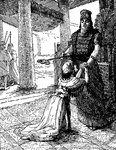
Esther Approaches King Xerxes
"Now it came to pass on the third day, that Esther put on her royal apparel, and stood in the inner…
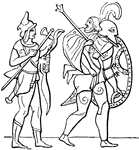
Sceptrum
"Sceptrum, which originally denoted a simple staff or walking stick, was emblematic of station and authority.…
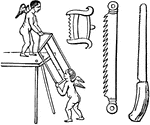
Serra
"Serra, a saw. It was made of iron. The form of the larger saw used for cutting timber is seen in the…

Speculum
"Speculum, a mirror, a looking-glass. The looking-glasses of the ancients were usually made of metal,…

Spira
"Spira, the base of a column. in the Tuscan and the Roman Doric the base consisted of a single torus,…

Cestus
"The cestus used in later times, in the public games, was a most formidable weapon. It was frequently…
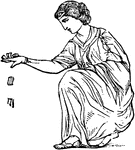
Talus
"Talus. The huckle-bones of sheep and goats were used to play with from the earliest times, principally…
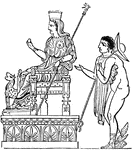
Thrones
"The following wood-cut from a fictile vase in the Museo Borbonico at Naples, represents Juno seated…
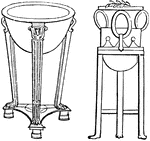
Tripos
"Tripos, a tripod, i.e. any utensil or article of furniture supported upon three feet. More especially,…
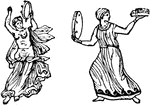
Tympanum
"Tympanum, a small drum carried in the hand. Of these, some resembled in all respects a modern tambourine…

Halt
"Carry the hand to the shoulder; rapidly thrust the hand upward the full extent of the arm several times."…

Change Direction Signal
"The hand on the side toward which the change of direction is to be made is carried across the body…

Hand signal
"To announce range, extend the arm toward the leaders or men for whom the signal is intended, fist closed;…
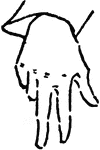
Hand signal
"To change elevation, indicate the amount of increase or decrease by fingers; point upward to indicate…
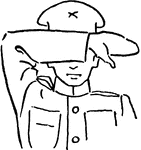
Suspend Firing
"Raise and hold the forearm steadily in a horizontal position in front of the forehead, palm of the…
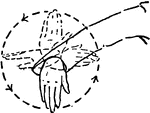
Hand signal
"Extend the arm horizontally toward the platoon leader; describe small circles with the hand." —…

Squad
"Extend the arm horizontally toward the platoon leader; swing the hand up and down from the wrist."…
Parade Rest
"Carry the right foot 6 inches straight to the rear, left knee slightly bent; clasp the hands, without…

Salute
"Raise the right hand smartly till the tip of the forefinger touches the lower part of the headdress…

Soldier with Rifle
"In resuming the order from any position in the manual, the motion next to the last concludes with the…
Order Arms Standing
"The butt rests evenly on the ground, barrel to the rear, toe of the butt on a line with toe of, and…
Present Arms
"With the right hand carry the piece in front of the center of the body, barrel to the rear and vertical,…
Port Arms
"With the right hand raise and throw the piece diagonally across the body, grasp it smartly with both…
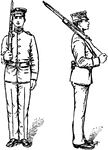
Right Shoulder, Arms
"Without changing the grasp of the right hand, place the piece on the right shoulder, barrel up and…
Left Shoulder, Arms
"Carry the piece with the right hand and place it on the left shoulder, barrel up, trigger guard in…
Parade Rest with Rifle
"Carry the right foot 6 inches straight to the rear, left knee slightly bent; carry the muzzle in front…
Trail Arms
"Raise the piece, right arm slightly bent, and incline the muzzle forward so that the barrel makes an…
Rifle Salute
"Carry the left hand smartly to the small of the stock, forearm horizontal, palm of hand down, thumb…
Rifle Salute
"Carry the left hand smartly to the right side, palm of the hand down, thumb and fingers extended and…
Inspection Arms
"At the second command take the position of arms. Seize the bolt handle with the thumb and forefinger…
Stack Arms
"Each even number of the front rank grasps his piece with the left hand at the upper band and rests…

Stack Arms
"Each even number of the front rank grasps his piece with the left hand at the upper band and rests…

Emperor Meiji
Emperor Meiji (November 3, 1852 – July 30, 1912), or Meiji the Great, was the 122nd Emperor of Japan…

Stack Arms
"Throws the butt about 2 feet in advance of that of his own piece and opposite the right of the interval,…
Stack Arms
"Each odd number of the front rank raises his piece with the right hand, carries it well forward, barrel…

Kneel
"Kneel on right knee, sitting as nearly as possible on the right heel; left forearm across left thigh;…
Lying Down
"If lying down, the left hand steadies and supports the piece at the balance, the toe of the butt resting…
